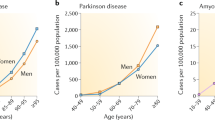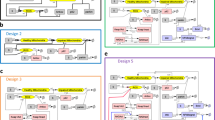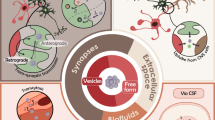Abstract
In genetic disorders associated with premature neuronal death, symptoms may not appear for years or decades. This delay in clinical onset is often assumed to reflect the occurrence of age-dependent cumulative damage1,2,3,4,5,6. For example, it has been suggested that oxidative stress disrupts metabolism in neurological degenerative disorders by the cumulative damage of essential macromolecules1,4,7. A prediction of the cumulative damage hypothesis is that the probability of cell death will increase over time. Here we show in contrast that the kinetics of neuronal death in 12 models of photoreceptor degeneration, hippocampal neurons undergoing excitotoxic cell death8, a mouse model of cerebellar degeneration9 and Parkinson's10 and Huntington's diseases are all exponential and better explained by mathematical models in which the risk of cell death remains constant or decreases exponentially with age. These kinetics argue against the cumulative damage hypothesis; instead, the time of death of any neuron is random. Our findings are most simply accommodated by a ‘one-hit’ biochemical model in which mutation imposes a mutant steady state on the neuron and a single event randomly initiates cell death. This model appears to be common to many forms of neurodegeneration and has implications for therapeutic strategies.
This is a preview of subscription content, access via your institution
Access options
Subscribe to this journal
Receive 51 print issues and online access
$199.00 per year
only $3.90 per issue
Buy this article
- Purchase on Springer Link
- Instant access to full article PDF
Prices may be subject to local taxes which are calculated during checkout




Similar content being viewed by others
References
Coyle, J. T. & Puttfarken, P. Oxidative stress, glutamate, and neurodegenerative disorders. Science 262, 689–695 (1993).
Cummings, J. L., Vinters, H. V., Cole, G. M. & Khachaturian, Z. S. Alzheimer's disease: etiologies, pathophysiology, cognitive reserve, and treatment opportunities. Neurology 51, S2– 17 (1998).
Alves-Rodrigues, A., Gregori, L. & Figueiredo-Pereira, M. E. Ubiquitin, cellular inclusions and their role in neurodegeneration. Trends Neurosci. 21, 516–520 (1998).
Cassarino, D. S. & Bennett, J. P. Jr An evaluation of the role of mitochondria in neurodegenerative diseases: mitochondrial mutations and oxidative pathology, protective nuclear responses, and cell death in neurodegeneration. Brain Res. Rev. 29, 1–25 (1999).
Selkoe, D. J. Translating cell biology into therapeutic advances in Alzheimer's disease. Nature 399, A23–A31 (1999).
Dunnett, S. B. & Björklund, A. Prospects for new restorative and neuroprotective treatments in Parkinson's disease. Nature 399, A32–A39 (1999).
Travis, G. H. Mechanisms of cell death in the inherited retinal degenerations. Am. J. Hum. Genet. 62, 503–508 (1998).
Dubinsky, J. M., Kristal, B. S. & Elizondo-Fournier, M. On the probabilisitic nature of excitotoxic neuronal death in hippocampal neurons. Neuropharmacology 34, 701–711 (1995).
Triarhou, L. C. Rate of neuronal fallout in a transsynaptic cerebellar model. Brain Res. Bull. 47, 219–222 (1998).
Fearnley, J. M. & Lees, A. J. Ageing and Parkinson's disease: substantia nigra regional selectivity. Brain 114, 2283–2301 (1991).
Schmidt, S. Y. & Aguirre, G. D. Reductions in taurine secondary to photoreceptor loss in Irish setters with rod-cone dysplasia. Invest. Ophthalmol. Vis. Sci. 26, 679–683 (1985).
Parshall, C. J., Wyman, M., Nitroy, S., Acland, G. & Aguirre, G. Photoreceptor dysplasia: an inherited progressive retinal atrophy of miniature schnauzer dogs. Prog. Vet. Comp. Ophthalmol. 1, 187–203 ( 1991).
Clarke, G. et al. Rom-1 is required for rod photoreceptor viability and the regulation of disk morphogenesis. Nature Genet. 25, 67–73 (2000).
Sanyal, S. & Hawkins, R. K. Genetic interaction in the retinal degeneration of mice. Exp. Eye Res. 33, 213–222 (1981).
Hawkins, R. K., Jansen, H. G. & Sanyal, S. Development and degeneration of retina in rds mutant mice: photoreceptor abnormalities in the heterozygotes. Exp. Eye Res. 41, 701–720 (1985).
Massof, R. W., Dagnelie, G., Benzschawel, T., Palmer, R. W. & Finkelstein, D. First order dynamics of visual field loss in retinitis pigmentosa. Clin. Vis. Sci. 5, 1–26 (1990).
Berson, E. L., Sandberg, M. A., Rosner, B., Birch, D. G. & Hanson, A. H. Natural course of retinitis pigmentosa over a three-year interval. Am. J. Ophthalmol. 99, 240–251 (1985).
Birch, D. G., Anderson, J. L. & Fish, G. E. Yearly rates of rod and cone functional loss in retinitis pigmentosa and cone-rod dystrophy. Ophthalmology 106 , 258–268 (1999).
Sauer, H. & Oertel, W. H. Progressive degeneration of nigrostriatal dopamine neurons following intrastriatal terminal lesions with 6-hydroxydopamine: a combined retrograde tracing and immunocytochemical study in the rat. Neuroscience 59, 401–415 (1994).
Li, Z.-Y. & Milam, A. H. in Degenerative Diseases of the Retina (eds Anderson, R. E., LaVail, M. M. & Hollyfield, J. G.) 1–8 (Plennum, New York, 1995).
Wen, R. et al. Injury-induced upregulation of bFGF and CNTF mRNAs in the rat retina. J. Neurosci. 15, 7377– 7385 (1995).
Seigal, G. S. & Liu, L. Inducible, apoptosis-promoting activity in retinal cell-conditioned medium. Mol. Vision 3, 14 (1997).
Carter-Dawson, L. D. & LaVail, M. M. Rods and cones in the mouse retina. I. Structural analysis using light and electron microscopy. J. Comp. Neurol. 188, 245– 262 (1979).
Erickson, P. A., Fisher, S. K., Anderson, D. H., Stern, W. H. & Borgula, G. A. Retinal detachment in the cat: the outer nuclear and outer plexiform layers. Invest. Ophthalmol. Vis. Sci. 24, 927–942 ( 1983).
Ratkowsky, D. A. Nonlinear Regression Modeling: A Unified Practical Approach (Marcel Decker, New York, 1983).
Kremer, B. et al. Influence of lamotrigine on progression of early Huntington’s disease: a randomized clinical trial. Neurology 53, 1000–1011 (1999).
La Vail, M. M. et al. Retinal degeneration in the nervous mouse. I. Light microscopic cytopathology and changes in the interphotoreceptor matrix J. Comp. Neurol. 333, 168–181 ( 1993).
LaVail, M. M., Blanks, J. C. & Mullen, R. J. Retinal degeneration in the pcd cerebellar mouse. I. Light microscopic and autoradiographic analysis. J. Comp. Neurol. 212, 217–230 ( 1982).
Acknowledgements
We thank the physicians of the Huntington's disease patients for their help and support of this study; M. LaVail for sharing unpublished data on P23H rhodopsin-expressing transgenic rats; and A. G. Kundson Jr, T. P. Dryja, D. J. Zack, H. Lipshitz, M. W. Salter and S. Meyn for critical reading of the manuscript. This work was supported by grants from the Foundation Fighting Blindness (R.R.M.), The Macular Vision Research Foundation (R.R.M.), The RP Eye Research Foundation of Canada (R.R.M.), MRC of Canada (M.R.H. and B.R.L.), the Canadian Genetic Disease Network (R.R.M. and M.R.H.) and the Huntington Disease Society of America (M.R.H.). M.R.H. is an Established Investigator of the BC Children's Hospital. R.R.M. is an International Research Scholar of the Howard Hughes Medical Institute.
Author information
Authors and Affiliations
Supplementary information
Rights and permissions
About this article
Cite this article
Clarke, G., Collins, R., Leavitt, B. et al. A one-hit model of cell death in inherited neuronal degenerations. Nature 406, 195–199 (2000). https://doi.org/10.1038/35018098
Received:
Accepted:
Issue Date:
DOI: https://doi.org/10.1038/35018098
This article is cited by
-
Aggregation of rhodopsin mutants in mouse models of autosomal dominant retinitis pigmentosa
Nature Communications (2024)
-
A nonsense mutation in C8orf37 linked with retinitis pigmentosa, early macular degeneration, cataract, and myopia in an arRP family from North India
BMC Ophthalmology (2023)
-
Late-stage rescue of visually guided behavior in the context of a significantly remodeled retinitis pigmentosa mouse model
Cellular and Molecular Life Sciences (2022)
-
HDAC inhibition ameliorates cone survival in retinitis pigmentosa mice
Cell Death & Differentiation (2021)
-
Rod function deficit in retained photoreceptors of patients with class B Rhodopsin mutations
Scientific Reports (2020)
Comments
By submitting a comment you agree to abide by our Terms and Community Guidelines. If you find something abusive or that does not comply with our terms or guidelines please flag it as inappropriate.



